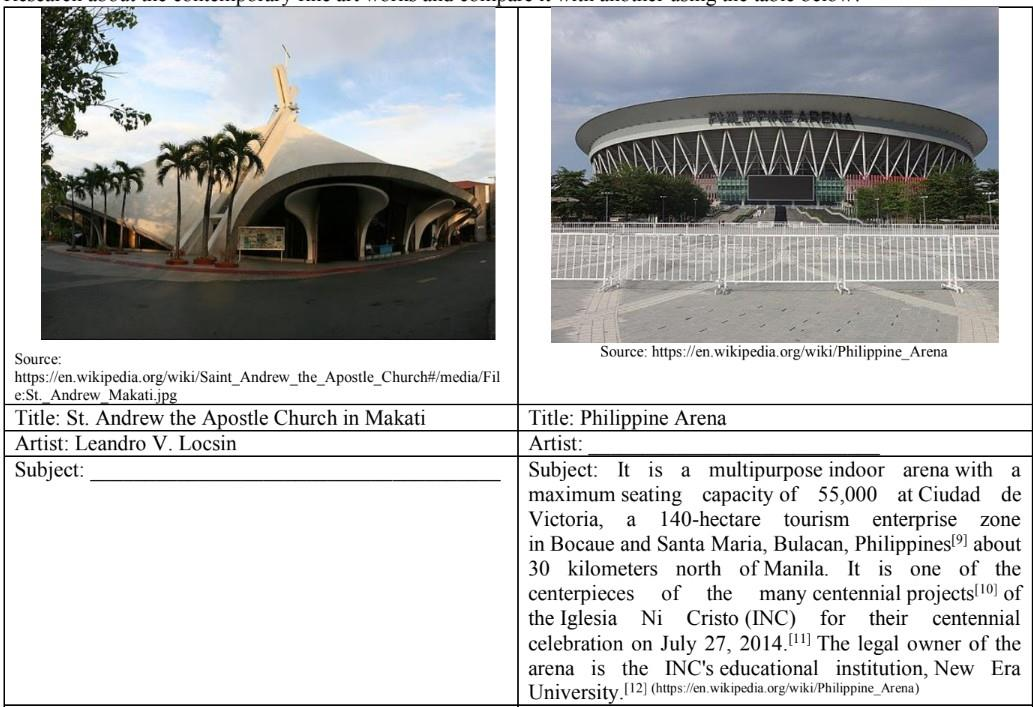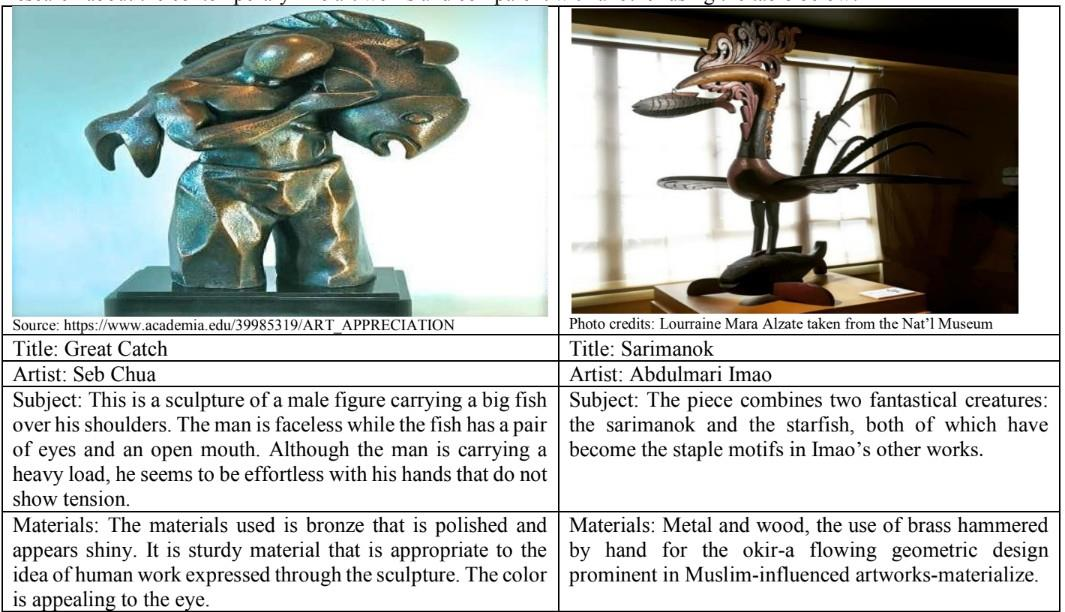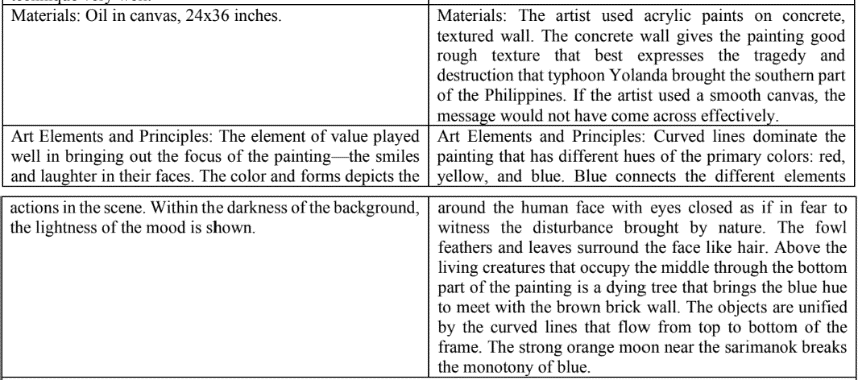REVIEWER-CPAR-1st-SEM-Q1.docx
CPAR
Humanities
- refers to the study of the human Experience- how people process and record Their thoughts, beliefs, and longings. It includes Philosophy, history, literature, art, music, and language as their modes of expression. Through these, we get to know how others have lived and thought about the challenges of life.
- From them, we get to decide what is important in our lives what we can do to make our lives better. Humanities deal with the expression of the internal world of a person, a world everything is subjective. This internal world includes a person's emotions, dreams, and aspirations.
Contemporary art
- Refers to current and very recent practice. It also refers to works of art made by living artists.
- tends to be assessed thematically and subjectively, drawing on an expanded range of theoretical and practical disciplines.
- can be driven by both theory and ideas, and is also characterized by ablurring of the distinction between art and other categories of cultural experience, such as television, cinema, mass media, entertainment and digital technology.
Contemporary Performance
- Contemporary performance is hybrid work that integrates text, dance, objects, music, costumes, lighting, image, sound, sets, and vocal expression into complex interactive systems.
- Contemporary performance collages are often non-narrative, technically rigorous, and carefully orchestrated anarchic chaos. They unsettle perception, demand critical engagement from audiences, address conceptual debates within aesthetics, draw on a diverse range of cultural interests, and bring pleasure to populations across the globe." (Morgan v. P. Pecelli)
THE SUBJECT OF ART
- Subject is any person, animal, thing, or issue that is described or represented in a work. It is different from theme or content (substance); theme is the recurring idea or element in a work of art. The theme refers to the ideas, thoughts, and feelings of the artist.
Different Ways of styles depicting a subject
- REALISM
- DISTORTION
- ABSTRACTION
- NON OBJECTIVISM
ELEMENTS OF ART
1. Space -In visual arts, space pertains to emptiness which may either be positive space or negative space
- Positive Space - The area of a design or work of art containing a design element. such as shapes. figures. objects. or text.
- Negative Space - The empty or open area surrounding and between the positive spaces.
2. Line - is the extension of a point, a short or long mark drawn or carved on a surface. It is an implied path suggesting – (a) direction: vertical, horizontal, diagonal (b) character: jagged, curved, series of dots or broken lines
3. Shape and Form
Shape can be described as a figure separate from its surrounding area or background. It can either be geometric (angular) or organic (curvy).
Form is slightly similar to shape. It is an enclosed line, a figure separates from its background. But, remember that shape is two-dimensional, while form is three dimensional. For instance, the square is an example of shape; the cube is a form. The circle is a shape; the sphere is a form. ..
4. Color - In visual arts, color is associated with the natural phenomenon in our environment. Scientifically, when a light passes through a prism, it will produce different hues of different wavelengths. These colors may pertain to lightness, darkness, coolness, or warmth
5. Value - In visual arts, value is the degree of lightness and darkness of a color. In music, it is called pitch, which is the highness or lowness of a tone. The tone color or timbre refers to the quantity of the sound.
6. Texture - is the surface of an artwork. It can be actual or tactile, meaning, it can really be felt by touch; or it can be simulated or illusory, which means it can only be seen, not felt. In music or writing, texture is the quality or style of a composition. The sound from different musical instruments allow one to hear texture in sound.
Principles of Design
- Harmony
It refers to the wholeness of the design, the pleasing arrangement of parts, and the agreement between parts of composition, resulting in a united whole
- Variety
It pertains to the assortment or diversity of a work of art.
- Rhythm
This refers to the repetition of certain elements to produce a pattern. In visual arts, repeated design elements may create a certain flow and may lead the viewer’s eyes.
- Proportion
refers to the relationship of the size of elements in a body of art.
- Movement
In arts, movement is the illusion of motion in a painting, sculpture design, or in a piece of art.
- Balance
refers to the even and equal distribution of elements
- Emphasis
is a principle which may refer to the greater impact given on a certain element.
PHILIPPINE ARTS
- Ethnic Tradition
art forms were primarily influenced by the area where our ancestors prosper
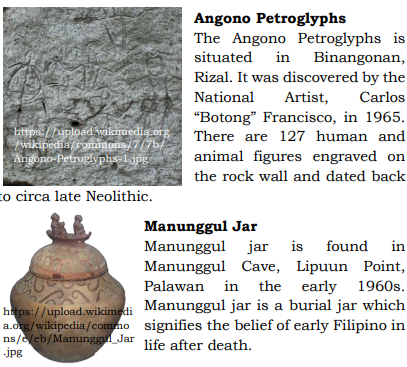
- Spanish Colonial Tradition
influenced by religion and secularization.

- American Colonial and Contemporary Arts Traditions
mainly influenced by education and governance
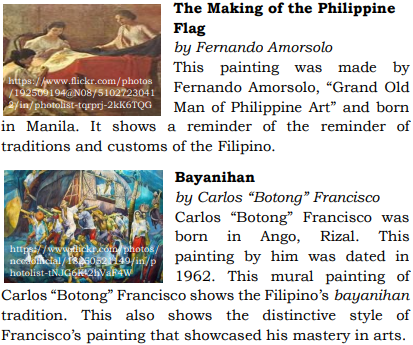
VARIOUS ARTS FORMS FOUND IN THE PHILIPPINES
Through migration and trade during pre-colonial period, there was a lively cultural interchange between the Philippines and other Asian countries. This helped the Philippines to develop their own way of living, their own culture such as pottery, weaving, wood carving, jewelry, etc. That they could use for their everyday living.
- PAINTING
- the expression of ideas and emotions, with the creation of certain aesthetic qualities, in a two- dimensional visual language. The elements of this language — its shapes, lines, colors, tones, and textures — are used in various ways to produce sensations of volume, space, movement, and light on a flat surface. The first paintings here in the Philippines are commissioned works during Spanish colonization. Here are some paintings from Luzon, Visayas and Mindanao.
- LUZON THE SKETCH BY VICTORIO EDADESSALAAM
- (PEACE) BY RAMEER TAWASIL MINDANAO
- MAGELLAN'S CROSS BY RAUL AGAS VISAYAS
FORMS OF PAINTING
- Easel painting
the easel painting is perhaps the most common form
of painting which involves applying color to a board or
canvas that is fixed on an upright support called an
easel. these are meant to be framed and hanged on a
wall after creating them.
- Murals
a mural is described as a huge wall-sized painting used
to impart messages to the public. a new form of.
mural which is a portable mural, was developed in
order to prevent the mural from being erased from the
wall which was created by using bold strokes in
applying bright colors on pieces of cheesecloth or
- Telon painting
a telon is describes as a backdrop or background for
the stage which are used for komedya, sarswela, and
sinakulo, the popular forms of theater in the country.
- Collage
This refers to a form of painting that involves combine
Images in a single artwork. This entails cutting and
Pasting materials such as paper, fabric, tin foil and
Other relatively flat materials onto a board or canvas
- DANCE
- refers to the movement of the body in a rhythmic way, usually to music and within a given space, for the purpose of expressing an idea or emotion, releasing energy, or simply taking delight in the movement itself. dances in the Philippines vary from region to region and below are some dances of the different regions.
TYPES OF FILIPINO DANCE
- Banga Illustrates the grace and strength of women in the Kalinga tribe of Cordillera Autonomous Region (CAR). Women performing the Banga balance heavy pots on their heads while dancing to beat of wind chimes.
- Lumagen or Tachok It is performed to celebrate happy occasions. When Lumagen is performed, it is meant to symbolize flying birds and is musically paired to the beat of gongs.
- Binaylan The Binaylan dance, tells the story of a hen, the hen's baby, and a hawk. In this dance, the hawk is said to control a tribe's well-being, and is killed by hunters after attempting to harm the hen's baby.
- Tinikling Take two long bamboo sticks rapidly and in rhythm, clap sticks for dancers to artistically and da ringly try to avoid getting their feet caught between them.
- Singkil In this dance, there are four bamboo sticks arranged in a tictac-toe pattern in which the dancers exploit very position of these clashing sticks. It is identifiable with the use of umbrellas and silk clothing.
- WEAVING
- is a method of textile production in which two distinct sets of yarns or threads are interlaced at right angles to form a fabric or cloth. Other methods are knitting, crocheting, felting, and braiding or plaiting. The longitudinal threads are called the warp and the lateral threads are the weft, woof, or filling. (weft is an old English word meaning "that which is woven"; compare leave and left.) The method in which these threads are interwoven affects the characteristics of the cloth.
- Textile weaving this refers to the process of creating cloth by interweaving a series of para vertical threads with another series of horizontal threads at right angles.
- Mat weaving this refers to the art of “plaiting strips of organic fibers into mats". These mats, locally known as banig, are cool, light, and portable compared to fixed beds.
- Basketry this refers to the art of creating containers by weaving, plaiting, or braiding materials into hollow three-dimensional shapes that can either be used for carrying, storage and trapping animals.
- Kalakat weaving- kalakat sheets are primarily used as a cheap but durable construction material. It is a preferred material for housing and resort cottages because of its cool and insulator characteristic. It is environment friendly as it utilizes basically an agricultural waste material.
- Free-standing this is a kind of sculpture that can independently stand in space. It has a flat horizontal base. All
its sides contribute to the overall form of the sculpture.
- SCULPTURING
- The sculpture is an art form in which hard or plastic materials are worked into three-dimensional art objects. Filipino sculptors came to be known in the middle of the 19th century. These are some of the sculptures in the Philippines.
- From the transitional carving of anitos to the santos to Christ and down to the saints, Filipinos find it rather not difficult as they are already familiar with the ways of the wood. It is a branch of the visual arts that operates in three dimensions. It is one of the plastic arts. Durable sculptural processes originally used carving and modelling; in stones, metals, ceramics, woods and other materials but, since Modernism, there has been an almost complete freedom of materials and process. In contrast to painting, sculpture has three dimensions — height, width, a depth. It is created by either carving, modelling, or assembling parts together.
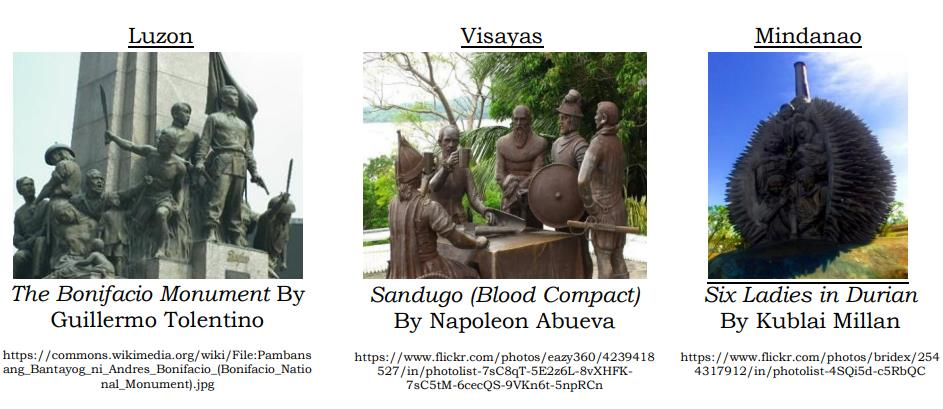 EXAMPLES:
EXAMPLES:
GENERAL KINDS OF SCULPTURE
- FREE-STANDING this is a kind of sculpture that can independently stand in space. It has a fla horizontal base. All its sides contribute to the overall form of the sculpture.
- RELIEF this kind of sculpture does not have a flat horizontal base. The form is projected from a flat surface.
- There are two types of relief - low relief or bas-relief which is slightly from the flat surface; and high relief. Cagayan de Oro's legendary river monster is an example of a relief sculpture.
- ASSEMBLAGE this sculpture is formed by putting together materials such as found objects, pieces of paper, sponges, wood scraps, and other materials. A good example of this is Lamberto Hechanova's Man and Woman.
- KINETIC SCULPTURE this is considered as a sculpture in motion because the entire sculpture or some parts of the sculpture are moving with the wind or are vibrating with the surrounding air.
FORMS OF SCULPTURE
- Wood carving in the southern Philippines, the maranao and tausug of Mindanao are known for their okir, ornate curvilinear designs and motifs applied to wood carving. The Principal okir designs are the sarimanok, the naga, and the pako rabong.
- Sarimanok it is the legendary bird or "artificial cock" that has become an ubiquitous symbol of maranao art. It is depicted as a fowl with wings and feathered tail, holding a fish on its beak o talons. The head is profusely decorated with scroll, leaf and spiral motifs.
- Naga it has form of an elaborate mythical serpent or dragon with vigorous scurve.
- Pako rabong it is a stylized growing fern with a broad base gracefully tapering upwards.
- POTTERY
- Is one of the oldest and most widespread of the decorative arts, consisting of objects made of clay and hardened with heat. The objects made are commonly useful ones, such as vessels for holding liquids or plates or bowls from which food can be served.
- Pottery is a general term for decorative and useful objects made from clay and set off at high temperatures. This is frequently interchanged with "ceramics". However, it is important to note that application of ceramics is wider and even includes industrial use.
FAMOUS POTTERY IN VARIOUS REGIONS
- The Manunggul Jar is a secondary burial jar excavated from a Neolithic burial site in the Manunggul cave of the Tabon Caves at Lipuun Point in Palawan. It dates from 890—710 B.C.[2J and the two prominent figures at the top handle of its cover represent the journey of the soul to the afterlife.
- Burnay jars are commonly used for storage of water or grains, as well as for fermenting of Vigan's local Basi wine and bagoong (fermented fish). It is said that burnay jars are much harder than the typical terracotta pots used in gardening.
- The Maitum anthropomorphic burial jars are earthenware secondary burial vessels discovered in 1991 by the National Museum of the Philippines' archaeological team in Ayub Cave, Barangay Pinol, Maitum, Sarangani Province, Mindanao, Philippines. The jars are anthropomorphic; characterized by a design that suggests human figures with complete or partial facial features of the first inhabitants of Mindanao. Furthermore, they give emphasis to the Filipinos' popular belief of life after death.
- ISLAMIC ART
- Islamic art is characterized by designs of flowers, plant forms and geometric designs. It is used in calligraphy, architecture, painting, clothing and other forms of fine arts. In the 13th century, traders and missionaries have introduced the religion of Islam in the Philippines. Islamic art meshed with ethnic culture and produced a Filipino Muslim Art that reflects the ethnic background and Islamic identity of the people.
- Calligraphy It is a visual art related to writing. It is the design and execution of lettering with a broad-tipped instrument, brush, or other writing instrument.
- ARCHITECTURE
- Architecture is considered to be one of the most functional branches of the visual arts. We can freely see architecture in our surroundings because architecture involves designing the form of a building while allowing the building to serve its function. It is considered to be the "art to inhabit." In relation to that, Philippine architecture was characterized as simple, rational, and functional. In the 20th century, the young Filipino who studied in American colleges and institutes introduced the neoclassic style in building structures. However, after World War II, real estate development started to take place (Sandagan & Sayseng, 2016). To illustrate these architectural designs, these are some examples from Luzon, Visayas and Mindanao.
EXAMPLES:
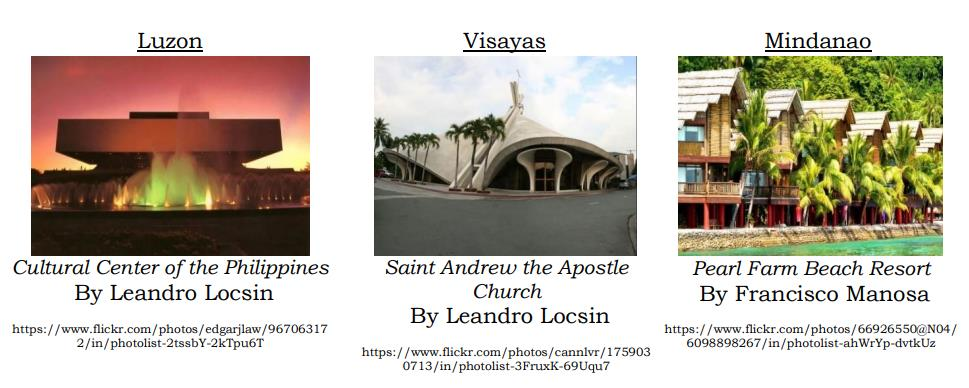
FORMS OF CONTEMPORARY ARCHITECTURE: DOMESTIC BUILDINGS AND HOUSES

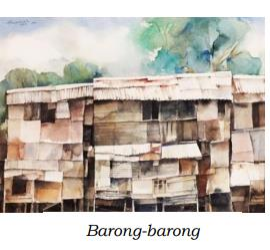

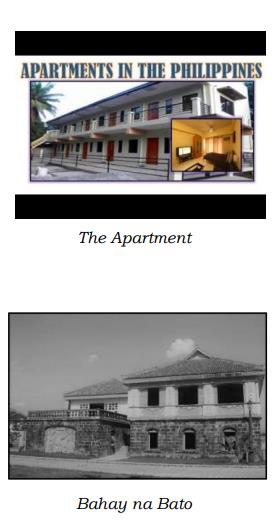
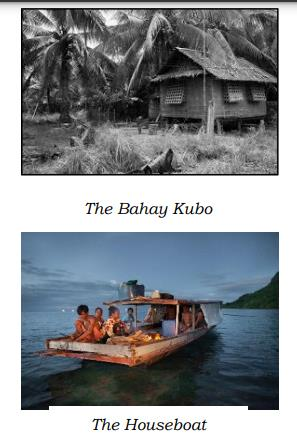 ETHNIC HOUSES
ETHNIC HOUSES
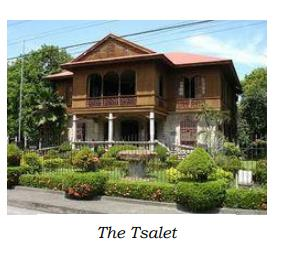
- FILM
- Film is a form of visual art use to imitate experiences that communicate ideas, stories, or feelings with the use of moving images. It is also called a movie or motion picture. Moreover, the art form that is the result of the film is called cinema (Faber & walters, 2003). The film industry in the Philippines started in 1897. In the contemporary period, martyr wife, superhero, action, melodramas, and comedies are some of the usual subjects and themes in the Philippine films. Some films in the Philippines are presented below.

- LITERATURE
- According to Lombardi (2020), literature is a term used to describe written and sometimes spoken material. Derived from the Latin word literature meaning "writing formed with letters," literature most commonly refers to works of the creative imagination, including poetry, drama, fiction, nonfiction, and in some instances, journalism, and song. These are some examples of Philippine literature.

- MUSIC
- Music is a collection of coordinated sound or sounds. According to Ramon P. Santos in his article entitled Contemporary Music, Contemporary music in the Philippines usually refers to compositions that have adopted ideas and elements from twentieth-century art music in the West, as well as the latest trends and musical styles in the entertainment industry. Filipino Music had already a rich and unique musical tradition long before Westerners set foot on our native land. Music was present in every stage of our ancestors' lives — from birth to death, in blissful or tragic times. Below are some Music from the
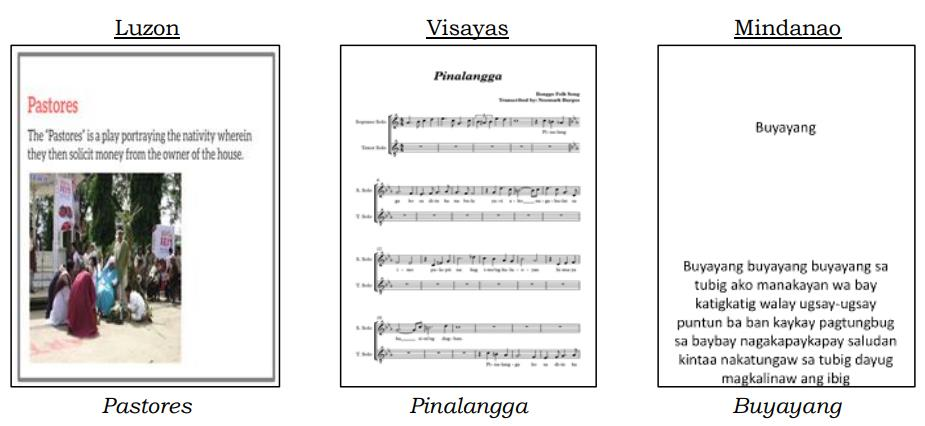 different Regions of our country
different Regions of our country- THEATRE
- is a collaborative form of fine art that uses live performers to present the experience of a real or imagined event before a live audience in a specific place. The performers may communicate this experience to the audience through combinations of gesture, speech, song, music, or dance.
MUSICAL INSTRUMENTS
Any tool or device that produces a sound - consists of an array of
Shapes and styles from simple to complex
- examples of which are kulintang, gangsa, kutyapi and guitar
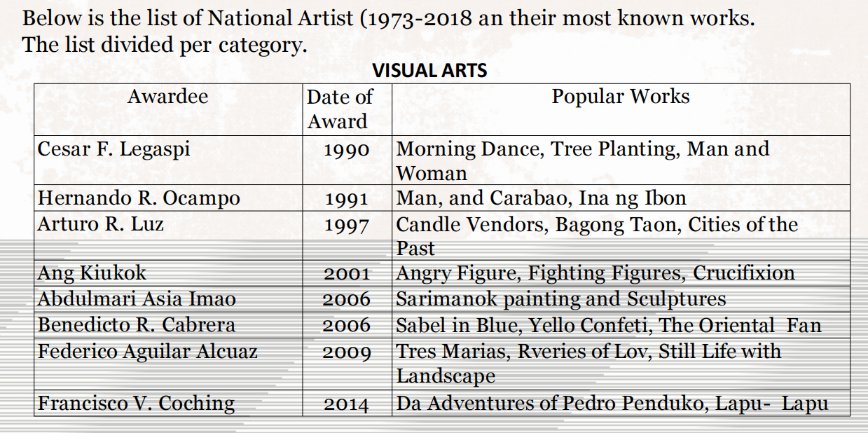 NATIONAL ARTIST
NATIONAL ARTIST
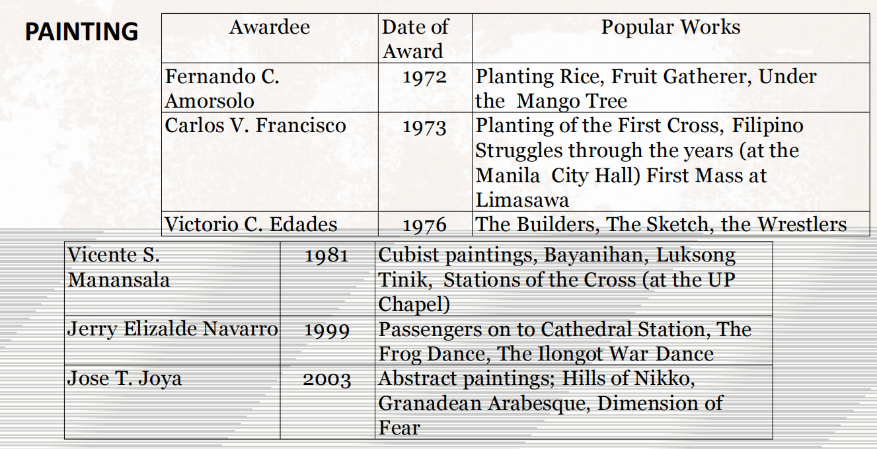
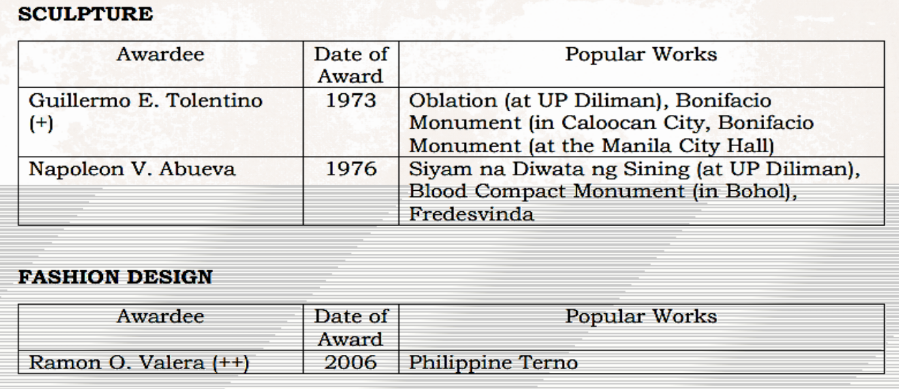
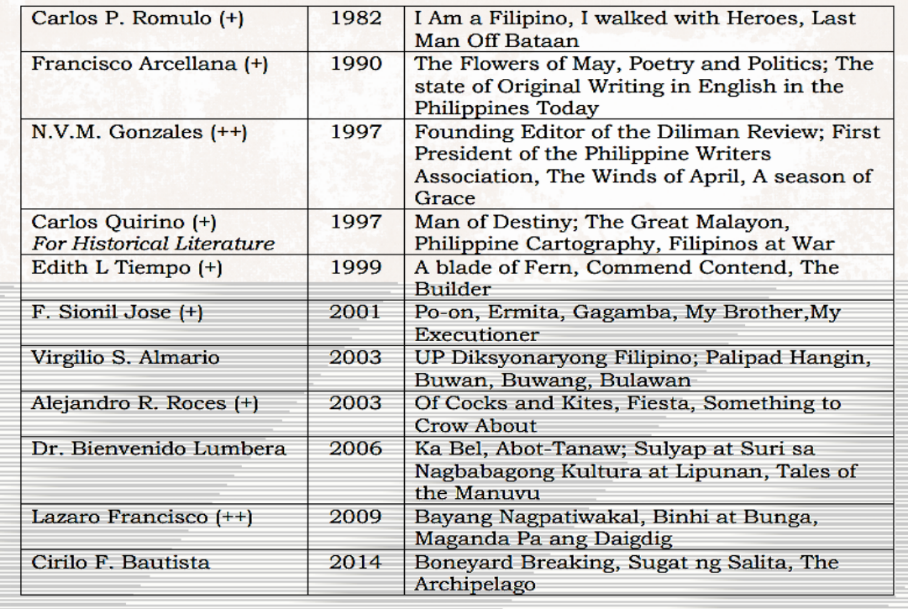
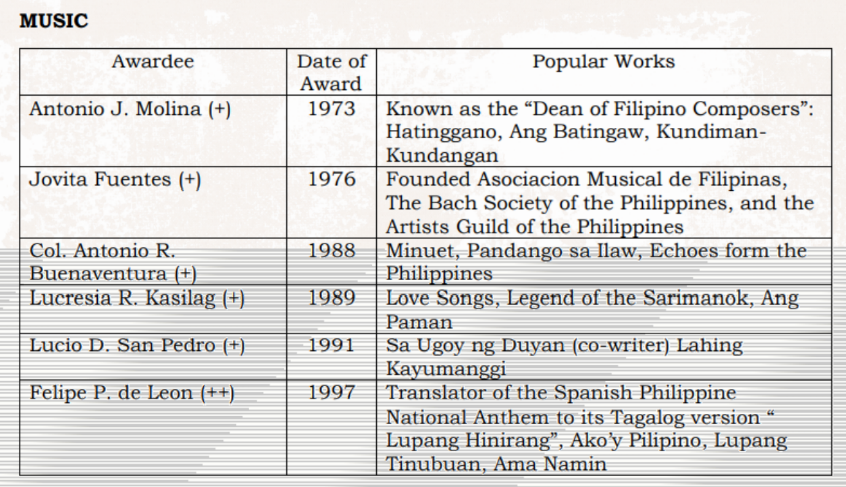
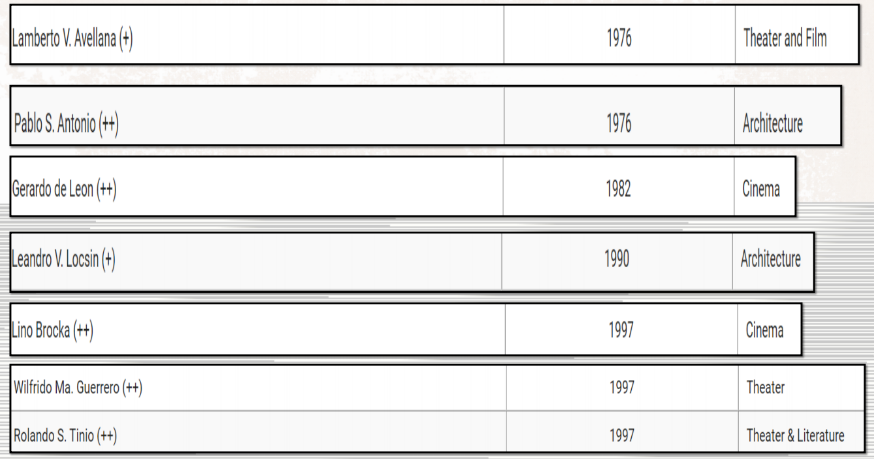
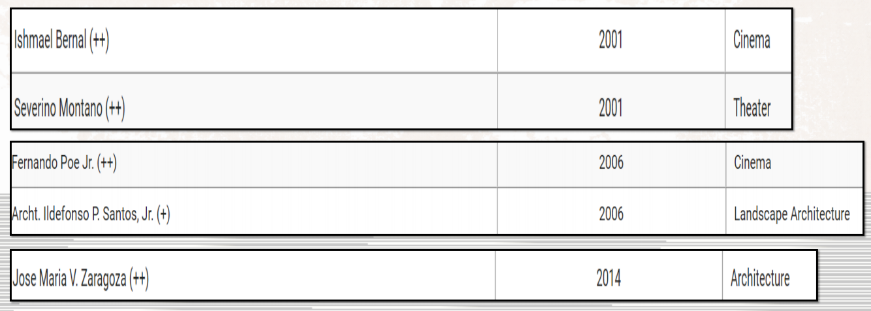
GAWAD SA MANLILIKHA NG BAYAN (GAMABA)
- The Philippines also honors artist who are engaged in folk or traditional arts and who have reached a high level of technical skill and artistic excellence. The award is called the Gawad sa Manlilikha ng Bayan (GAMABA) Or National Living Treasures Award.
- The categories for GAMABA are folk architecture, maritime transport, weaving, carving, performing arts, literature, graphic and plastic arts ornament, textile or fiber art, pottery, and other artistic expressions of traditional culture.
- This award was institutionalized by 1992 Republic Act No. 7355, with the NCCA in charge of its implementation. The process of awarding a Manlilikha ng Bayan is like that of the Order of the National Artists.
- However, only NCCA’s ad hoc panel of experts and reviewers will screen and review the nominations. They will then, submit the list to the President of the Philippines for proclamation.
Like the National Artists, an artist must have special qualities to become a Manlilikha ng Bayan. Below are the Criteria.
1. The artist should be an inhabitant of an indigenous/traditional, cultural community anywhere in the Philippines that has preserved indigenous customs, beliefs, rituals, and tradition and or has syncretized whatever external elements that have influenced it.
2. The artist must have engaged in a folk-art tradition that has been existence and documented for at least fifty years.
3. The artist must have consistently performed or produced works of superior and distinctive quality over a significant period.
4.The artist must possess a mastery of tools and materials needed by the art and must have an established reputation in the art as master and maker of works of extraordinary technical quality.
5.The artist must have passed on and or will pass on to other members of the community his/her skills in the folk art for which the community is traditionally known
A traditional artist who possesses all the qualities of a Manlilikha ng Bayan candidate but is now incapable of teaching further his/her craft, may still recognized given the following.
1.The artist has created a significant body of work and or/has consistently displayed excellence in the practice of his/her art, thus achieving important contributions for its development.
2.The artist has been instrumental in the revitalization of his/her community artistic tradition.
3.The artist has passed on to the other members of the community the skills in the folk art for which the community is traditional known.
4.The community of the artist has recognized him/her as master and teacher of his/her craft.
WORLD-CLASS ARTISTS
The Philippine contemporary arts have so developed and matured that our artists can now stand proudly on the world stage.
- El Gamma Penumbra - a shadow play group of young locals from Tanauan, Batangas. The group won first place in the first television production of Asia’s Got talent in Singapore in May 2015. They have conquered the hearts not only of the Filipinos but of Asians as well. In visual arts, the Filipinos have also made a big scene. Once again, the Philippines is participating in the Venice Biennale after fifty-one years of absence. The Venice Biennale is a prestigious international art exhibition that started in 1895. One of its aims is to showcase the latest work of art from different nations.
- Patrick Flores - professor of Art Studies and curator of the Vargas Museum of the University of the Philippines, was chosen to curate the Philippine Pavilion. He named the exhibit “Tie a String around the World”. Representing the Philippines are artists Jose Tence Ruiz, Manny Montellano, Gus Albor, Lito Carating and Jing Turalba. It is wonderful to know that Philippine Pavilion has been named in the best list and a “must see” among the international pavilions.
- Cecil Licad – among the first contemporary artists to be acclaimed internationally is a gifted classical pianist. As a child prodigy, she made her debut at the age of seven as soloist with the Philippine Harmonic Orchestra. She was also one of the youngest musicians to receive the prestigious Leventritt Competition Gold Medal in 1981.
- Lea Salonga - one of several hundred Asian aspirants to be chosen for the role of Kim in the 1989 musical Miss Saigon in London and later in Broadway for which she received a Tony Award. The Tony award is Broadways equivalent to Hollywood’s Academy Award, or Oscars. She also performed as Fantine and Eponine in another hit musical, Les Miserables; as singing voice of both Mulan in the Disney movie Mulan; and Princess Jasmine in another Disney film Alladin.
- Lisa Macuja-Elizalde - the country’s first prima ballerina is the first foreign soloist to join Kirov Ballet, a famous Russian ballet company. She has won several awards both national and foreign- for her recitals. One of these awards is a spot in 1997 Ten Outstanding Young Persons of the World in the USA. She was also given the Order of International Friendship by Russian President Vladimir Putin in 2001.
- Charice Pempengco (a.k.a Jake Zyrus) - became famous when Ellen Degeneres discovered her on You Tube a few years ago. After a short stint in the United States, she has returned and is now a popular recording artist.
Philippine arts today are active and vibrant because of the Filipino artist’ talent, creativity, skill and their perseverance even in times of turmoil that drive them to pursue their dreams.
FILIPINO ARTISTS’ ROLES AND IDENTIFY THEIR CONTRIBUTION TO CONTEMPORARY ARTS
Various art forms before contemporary era
- VISUAL ART
Drawing, Painting, Sculpture, Calligraphy. Photography
- APPLIED ART Architecture, Fashion, Pottery, Jewelry Design, Interior Design
- PERFORMING ART AND OTHERS Dancing, Music, Theater Arts, Film productions Literature
Various contemporary art forms integrative arts
- Choreography
- Musical Instruments
- Literary and Musical Compositions
- Visual Designs and Applied Arts Combined
- Theatrical Performance
- Cinema
ARTIST - one who professes and practices an imaginative art.
Roles:
- The Personal-artist expresses what he/she feels
- The Social-expresses what he/she sees around him/her
- The Physical-need to create something not only pleasing to look at but something useful as well
- The Immaterial-artist gives form to the immaterial, hidden truth of the universe, and the spiritual force that inhabits the world
Distinct Roles
The Filipino Artist
- Gives his/her opinion about the culture of his time
- Is a crusader, attempting to sway the viewer to his/her side
- Has become a social critic-social realism
- Has also become an advocate for what she believes in
- Is versatile
Few women were recognized before the contemporary era
- Anita Magsaysay Ho
Anita Magsaysay-Ho was a pioneering artist and one of the first modernists in the Philippines.
- Nena Saguil
One of a handful of Filipino artists to delve into abstraction in the 1950s, Nena Saguil was the only woman to feature in an unprecedented exhibition of non-objective art organized by the Philippines’ first art critic, Aurelio Alvero, in 1953.
- Purita Kalaw Ledesma
Purita kalaw-ledesma (b. 1914, manila; d. 2005) was a seminal figure in philippine art. She was an artist and a writer, a curator and cultural worker, a patroness and collector.
She was the founder and the first president of the longest surviving art organization in the country, the Art Association of the Philippines (AAP), established in 1948 after the end of the Second World War
Women in Contemporary Arts
- Imelda Cajipe-Endaya
Imelda is a painter and installation artist,an art curator, founder of Kasibulan Foundation (group of artist)
FEMINISM
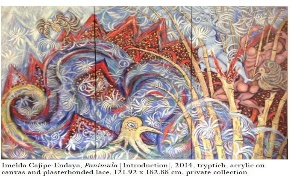


- Ofelia Gelvezon-Tequi
Ofelia-hailed from Ilo-ilo, UP Fine Arts Advocate of southern arts

- Brenda V. Fajardo
Brenda is a Professor Emeritus of the UP Diliman Philippine Folklore, legends and mythology, pen and ink Multi-awarded artist
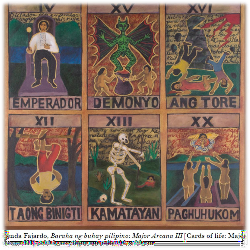

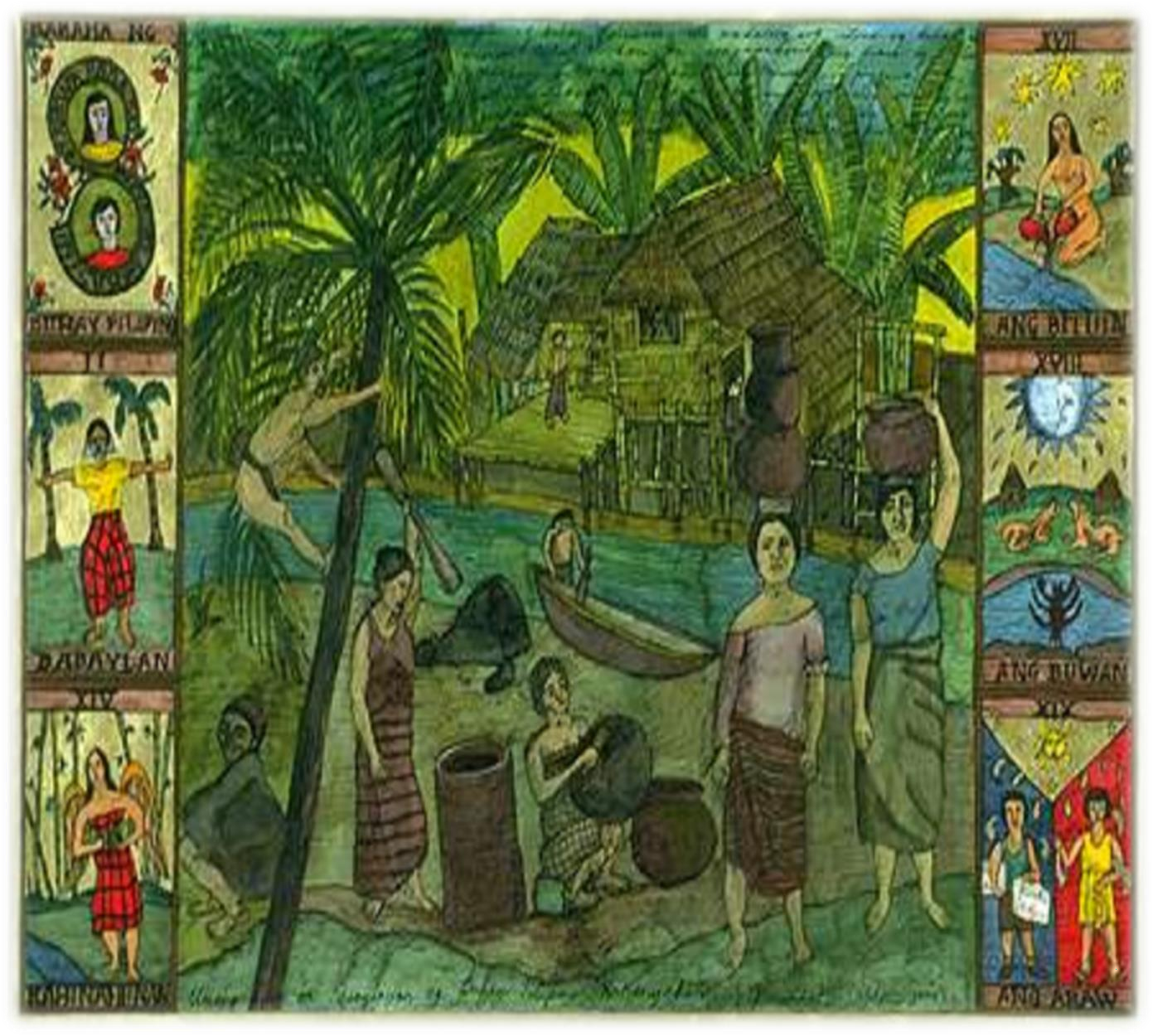
NATIONAL ARTIST OF THE PHILIPPINES:
•Proclamation No. 1001s. 1972
• Highest award conferred by the President of the Philippines to a nations artist
Fernando Amorsolo y Cueto (1892-1972)
•First National Artist1972
•"Grand Old Man of Philippine Art”
QUALIFICATIONS OF NATIONAL ARTIST OF THE PHILIPPINES:
- Filipino Citizens for at least 10 yrs
- Helped build a Filipino sense of nationhood thru content and form of their works
- Created significant body of works and/or have consistently displayed excellence in the practice of their art form, enriching artistic expression or style
- Enjoy broad acceptance three prestigious national and/or international recognition, awards in prestigious national and international events, critical acclaim and/or review of their works and or respect and esteem from peers within an artistic discipline.
- Distinguished themselves by pioneering in art made of expression or style, making an impact on succeeding generations of artists
STEPS IN BECOMING A NATIONAL ARTIST OF THE PHILIPPINES:
- Secretariat announces opening of nominations
- NCCA/CCP accepts nomination and screen the nominees
- NCCA/CCP recommends to the Pres. Of the Phils.
- Pres proclamation to awardees
- Awarding ceremonies
- Rank and title of National Artist as proclaimed by the Pres of the Phils
- Insignia of a National Artist and a citation
PRIVELEGES OF A NATIONAL ARTIST OF THE PHILIPPINES:
Lifetime emolument & material & physical benefits comparable in value to those received by the highest officers of the land:
- P100K living
- P75K deceased
- Monthly pension, med/hosp benefits
- Life insurance coverage for insurable awardees
- State funeral/burial at LNB
- Place of honor, protocolar precedence, national state functions & recognition at cultural events (VIP Treatment)
The Order of National Artists
- (Orden ng mga Pambansang Alagad ng Sining) is the highest national recognition given to Filipino individuals who have made significant contributions to the development of Philippine arts; namely, Music, Dance, Theater, Visual Arts, Literature, Film, Broadcast Arts, and Architecture and Allied Arts. The order is jointly administered by the National Commission for Culture and the Arts (NCCA) and the Cultural Center of the Philippines (CCP) and conferred by the President of the Philippines upon recommendation by both institutions.
National Living Treasures Award Gawad sa Manlilikha ng Bayan (GAMABA)
Philippine traditional crafts are still found in many Filipino homes and are used in fashion and the tourism industry.
Honors artists who are engaged in folk or traditional arts and who have reached a high level of technical skill and artistic excellence
Categories:
Folk architecture; maritime transport; weaving; carving; performing arts; literature; graphic and plastic arts; ornament; textile or fiber art; pottery; and other artistic expressions of traditional culture
Institutionalized by 1992 Republic Act No. 7355
Manlilikha ng Bayan is a traditional Filipino artist with a significant body of work, and is crucial in the transfer of artistic tradition.
GAMABA CRITERIA
The artist should be an inhabitant of an indigenous/traditional cultural community anywhere in the Philippines that has preserved indigenous customs, beliefs, rituals, and traditions and/or has syncretized whatever external elements that have influenced it.
The artist must have engaged in a folk art tradition that has been in existence and documented for at least fifty years.
The artist must have consistently performed or produced works of superior and distinctive quality over a significant period.
The artist must possess a mastery of tools and materials needed by the art, and must have an established reputation in the art as master and maker of works of extraordinary technical quality.
The artist must have passed on and/or will pass on to other members of the community his/her skills in the folk art for which the community is traditionally known.
How to recognize those who are incapable of teaching his/her craft:
The artist has created a significant body of works and/or has consistently displayed excellence in the practice of his/her art, thus achieving important contributions for its development.
The artist must have been instrumental in the revitalization of his/her community’s artistic tradition.
The artist has passed on to the other members of the community the skills in the folk art for which the community is traditionally known.
The community of the artist has recognized him/her as master and teacher of his/her craft.
National Living Treasures Awardees (1993-2012)
- Ginaw Bilog
Indigenous Group: Hanunuo Mangyan (Mansalay, Panaytayan, Oriental Mindoro)
Cultural Contribution: Poet; preserved Ambahan, a Mangyan tradition of singing or chanting, poetry
Additional Information: Ambahan is form of poetic literature which is made up of seven-syllable lines used to communicate messages through metaphors and imagery
- Masino Intaray
Indigenous Group: Pala’wan (Makagwa Valley, Brookes Point, Palawan)
Cultural Contribution: Musician, epic chanter like tuturan (myths), tultul (epics) and sudsungit (narratives), and storyteller; mastered of basal, kulilal, and bagit; played aroding and babarak
Additional Information: Tuturan, Tultul, and Sudsungit are the distinct Palawan folk literatures
- Samaon Sulaiman
Indigenous Group: Magindanaon (Mamasapano, Maguindanao)
Cultural Contribution:Musician; mastered of kutyapi (musical instrument) and served as a master teacher; popular town barber and imam
- Lang Dulay
Indigenous Group: T’boli (Lake Sebu, South Cotobato)
Cultural Contribution: Master textile weaver of the traditional t’nalak (T’boli cloth –abaca fibers); honing her skills at the age of 12; her distinct designs – kabangi(butterfly), bankiring (hair bangs), and bulinglangit (clouds)
Additional Information: Traditional T’boli weaving uses two distinct sets of threads that are knitted at right angles to create an elaborate design.
- Salinta Monon
Indigenous Group: Bagobo (Bansalan, Davao del Sur)
Cultural Contribution: Preserved the dying art of Bagobo weaving or inabal (ikat-dyed woven abaca (Musa textilis) cloth) (abaca-ikat); binuwaya (crocodile) as her beloved design
- Alonzo Saclag
Indigenous Group: Kalinga (Lubugan, Kalinga)Cultural Contribution: Musician and dancer; mastered in playing Kalingainstruments and dancing patterns and movements associated with rituals; and advocated the Kalinga philosophies; honed his skills through observation; established Kalinga Budong Dance Troupe
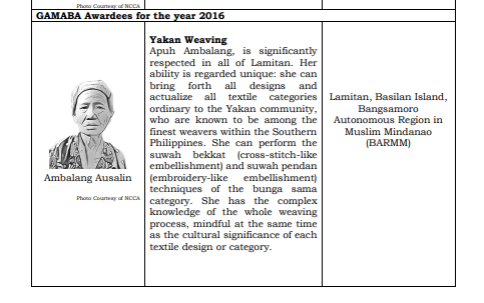 Federico Caballero
Federico Caballero
Indigenous Group: Sulod-Bukidnon (Calinog, Iloilo)
Cultural Contribution: Epic chanter; mastered 10 epics (like Labaw Dunggonand Humadapnon); documented their oral literature; advocated the preservation of their traditions; considered him as bantugan (person who achieved distinction) and manughusay(intermediary of conflicts)
- Uwang Ahadas
Indigenous Group: Yakan (Lamitan, Basilan)Cultural Contribution: Musician: mastered and taught several Yakan instruments (like kwintangankayu, gabbang, and agung) / partially blind
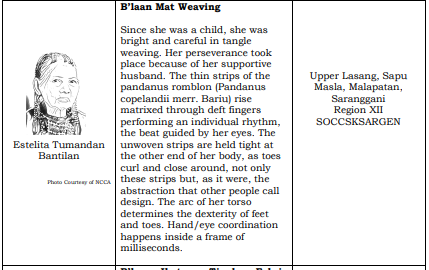 Additional Information: The Yakan people believed that instrumental music is deeply connected to life and agriculture cycles, and social undertaking
Additional Information: The Yakan people believed that instrumental music is deeply connected to life and agriculture cycles, and social undertaking
- Darhata Sawabi
Indigenous Group: Tausog(Parang, Jolo, Sulu)Cultural Contribution:
Textile weaver; mastered of traditional pissyabit (hood by the Tausugs)
- Eduardo Mutuc
Indigenous Group:Kapampangan (Apalit, Pampanga)
Cultural Contribution: Metal smith; sculptor of religious and secular art in silver, bronze, and wood, intricate church retablos and carosas
- Haja Amina Appi
Indigenous Group: Sama (Ungos Matata, Tandubas, Tawi-tawi)
Cultural Contribution:Mat weaver; mastered of Sama women tradition of mat weaving (sasaand kima-kima)
Additional Information: Mat weaving in the Sama community is a task for the women.
- Teofilo Garcia
Indigenous Group:Ilocano (San Quintin, Abra)
Cultural Contribution: Casque maker; Mastered of making tabungaw / headpiece
- Magdalena Gamayo
Indigenous Group: Ilocano (Pinili, Ilocos Norte)
Cultural Contribution: Textile weaver; mastered of Ilocos abel weaving (traditional blanket); traditional patterns of sinan sabong (flowers), kusikos (spirals), and binakol inuritan(geometrics) Magdalena
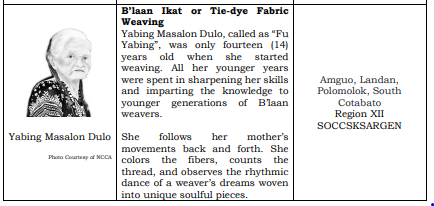
ART CRITICISM
- The art of criticism dated back in the 18th century from the works of Jonathan Richardson, “An Essay on the Whole Art of Criticism as It Relates to Painting and an Argument in Behalf of the Science of a Connoisseur (both 1719)”.
- He was able to develop a practical system of critical evaluation like the utilitarian calculus of Jeremy Bentham.
- An established hierarchy of values that anyone could use and simply put it as a matter of ratings.
- Come mid-18th century, Alexander Gottlieb Baumgarten created the discipline of aesthetics, giving it a place as a separate philosophical study, and in so doing, afforded judgment. In new criteria for critical his most important work, Aesthetica (1750–58), he sets forth the difference between a moral and exclusively aesthetic understanding of art, a way of thinking that can be regarded as the major difference between a traditional and modern approach to art making and art criticism.
- Later in the century, Immanuel Kant’s Critik der Urteilskraft (1790; “Critique of Judgment”) introduced the ideas of a disinterested judgment of taste, the purposiveness of artistic form, and the difference between the beautiful and sublime. These ideas remain influential to the present day, especially in the formalist criticism that would dominate the mid20th century. (Britannica)
STEPS IN ART CRITICISM:
- Description
- the general information, you discuss the subject matter, the materials used and the art form itself.
- You have to know the factual truth and research on answering the following questions:
- What is the Title?
Gives the audience a clue on what message the artist wish to convey - Who is the Artist?
The one who influences or affect the viewer - When and where was it created?
Usually produced in the modern era. It resonates a clear understanding of where the artwork originated or where the artist is coming from. - What media was used?
Highlights the contemporary era through the use of advancements in innovation and Information and Communications Technology. - Is there a primary subject in the piece?
By determining the subject in an artwork, will make you realize what it represents.
- What specific elements of Art can you find in the masterpiece?
Provides you with the sensual and substantial features of an art form.
- Analysis
- Looking into the artwork is 100% objective.
- The focus here is on the style of the artist as shown in his masterpiece, particularly the design and value to the viewer.
- This is where you decide what features suggest and decide why the creator used these to convey specific ideas.
- How do elements of art interact with each other? How do they work together as a whole?
- What specific elements stand out? Distinguish if it works or not in the obra?
- What principle of design can you find?
- Interpretation
- The focus here is the expressive qualities, the meaning, theme, mood, or idea communicated by the artist.
- This part is subjective in nature as it requires a critic their own personal opinion or preference, but then again,
- you will have to answer the following questions to have a more educated way of looking into an artwork.
- What is the artist trying to tell?
- What thoughts or feelings does the viewer have when they look, feel, hear the artwork?
- Express your opinion but always back it with an evidence or reason.
- Judgement
- the combination of the steps 1, 2, and 3
- last part in which you decide on the beauty of the work
- Do you like it? Why or why not?
- Is the artwork effective?
- What criteria do you think is important that helped you in concluding your judgment?
COMPARING AND CONTRAST
- Art is everywhere, in everything that you do art is always present. Art allows us to express our creativity and nurtures imagination. Through painting, sculpture, photography, or another medium, artistic works allow individuals to express feelings, thoughts and observations while allowing us to appreciate what is around us or to see the world around us in different ways. Art is beauty, but beauty, as they say, is in the eye of the beholder. As such, art also allows us to find pleasure in the sight of clouds or the splendor of a meadow, in the experience of the mundane or the excitement of the extraordinary, but also where beauty is not usually perceived, such as a rooftop, a factory, or a gritty streetscape.
What are the things to consider in comparing and contrasting art works?
- TITLE
- ARTIST
- PLACE
- SUBJECT
- MATERIALS
- ART ELEMENTS AND PRINCIPLES
- COMPARISON
Contemporary Fine Arts
- “The fine arts consist of architecture, sculpture, and painting. Some fine arts are made in two dimensions where the material or medium is applied to a flat surface to create an image. This is usually hung on the wall, as in the case of a painting. There are also three-dimensional fine arts, such as architecture and sculpture in ice, metal, or glass where molding, carving, and combining materials are done to make an artwork.”
Contemporary Painting
- is the most popular among the fine arts since the materials used for this medium are flexible, durable, and inexpensive. It attracts many temperaments and almost any theme can be treated through this genre.
Contemporary Sculpture
- is an art form that requires the artists creative use of balance. Skill in the use of materials, and physical strength. For many centuries, the common subject matter was the human figure, with materials limited to marble, metal, and wood. This has changed in contemporary sculpture, where new materials and technology have given the sculptor more choices and flexibility in artmaking.
Contemporary Architecture
- in the fields of science and art. As a science, technology techniques, architectonics, engineering, and tectonics are applied. As an art, the structure is designed creatively, which is determined by its function and purpose, the space that it will occupy, and the people who will occupy it. In contemporary architecture deletes itself to environment planning, city planning, space planning, landscape architecture, interior design, and urban design.
Contemporary Visual Arts
- visual art is another group of art genres that is seen by the eye and perceive by the mind. Unmoving as well as moving images, appeal to visual perception and this makes the scope of visual art very broad. For purposes of classification, we group under visual arts the art forms that make use of new media: installation art, public art, mix and multimedia art, photography, and digital arts.
- There are visual arts that require the use of equipment like cameras, video recorders, our computers, the capture of images in a creative way. These art forms include photography and digital art. When combined with other materials, they are referred to as “mix or multimedia” art. As such, art is capable of interpretation of life which enables us to cope more successfully with a chaotic state of things to bring from life a better, that is, a more convincing and more reliable meaning.
- One of the mainstream contemporary visual arts that we have now is installation art. It is often identified with three sculptures because of its three-dimensional forms and techniques employed in it really the tremendous change in sculptural attitude has influence installation artist. It is a labor intensive, and the artist usually works with fellow artists and assistance with welding, carpentry, construction, and fabrication skills because installation art involves a combination of several things: architectural setting, environment site, use of everyday objects in a specific context, and the viewer or participant.
Contemporary design in Art Crafts
- in the Philippines regions take the form of bags, mats, textile, baskets, footwear, ceramic pot, play pottery, jewelry, metal work, to name some. It requires putting together different materials from pandan ( seagrass ), coconut leaves, abaka, buri (palm), pinya, shell or bamboo. What parts in the different regions have evolved as they have been influenced by globalization, new techniques aided by technology, global aesthetic, and market demand.
- For example, Banig is made from pandan or seagrass and we’re traditionally woven into sleeping mats in its natural color. Today, different types of bunnies are produced in different colors and are designed with flowers, birds, landscapes, or geometric shapes. Aside from sleeping maths, they are also made into bags, wall decors, and throw pillow cases.
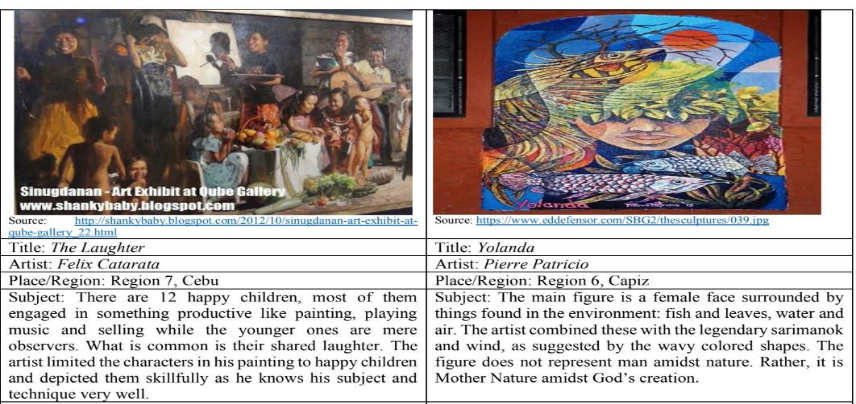 EXAMPLES OF COMPARING AND CONTRAST
EXAMPLES OF COMPARING AND CONTRAST
